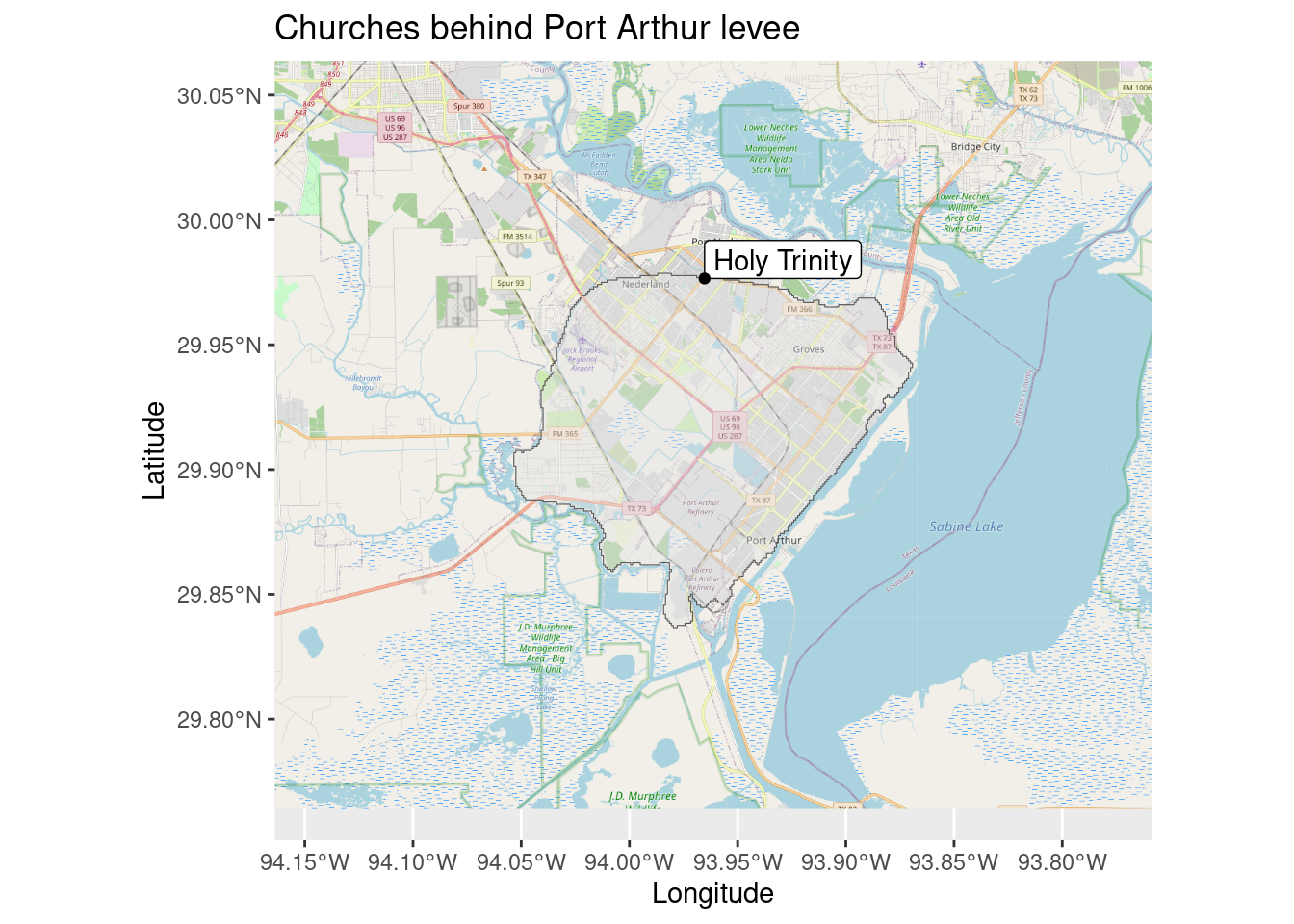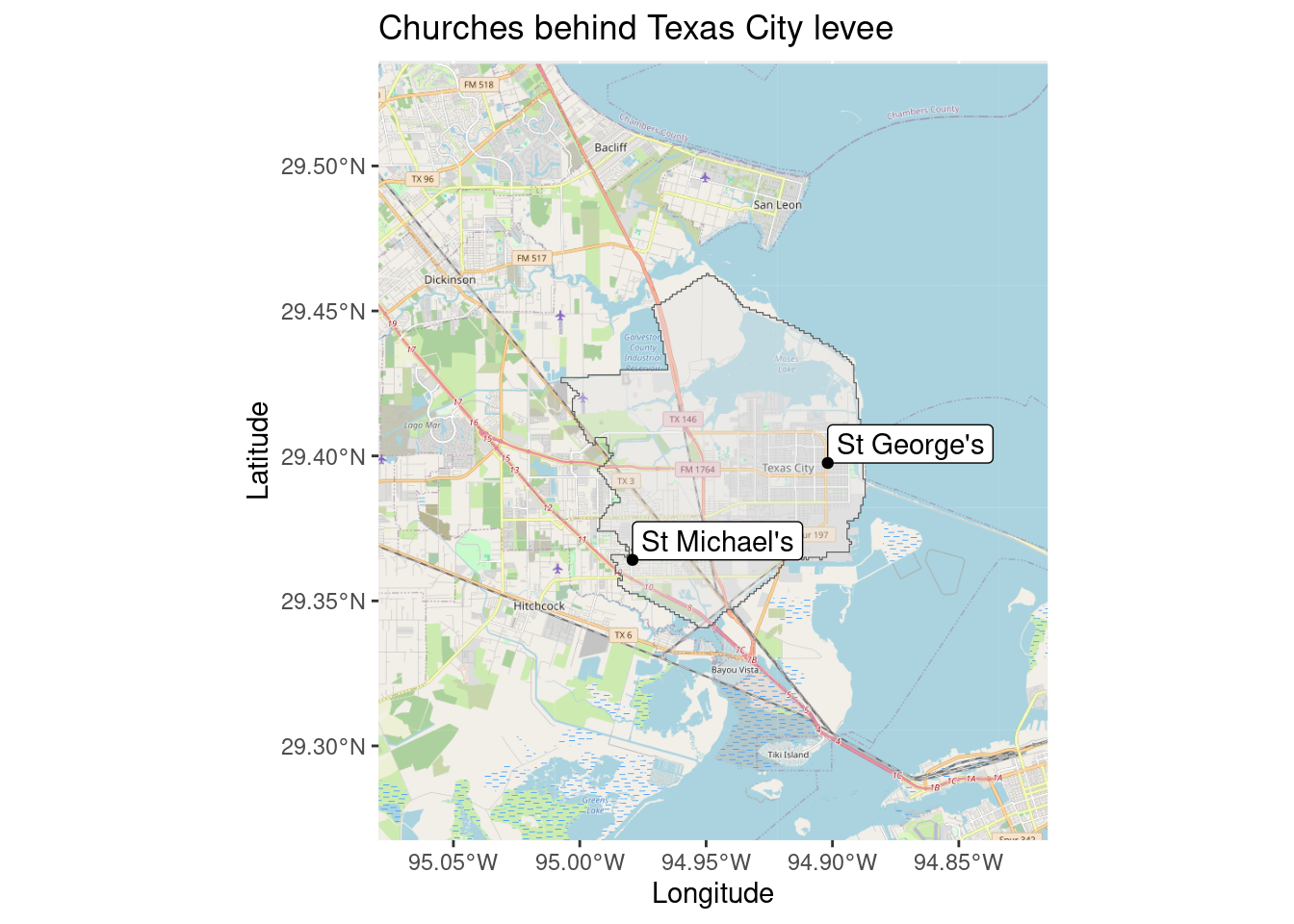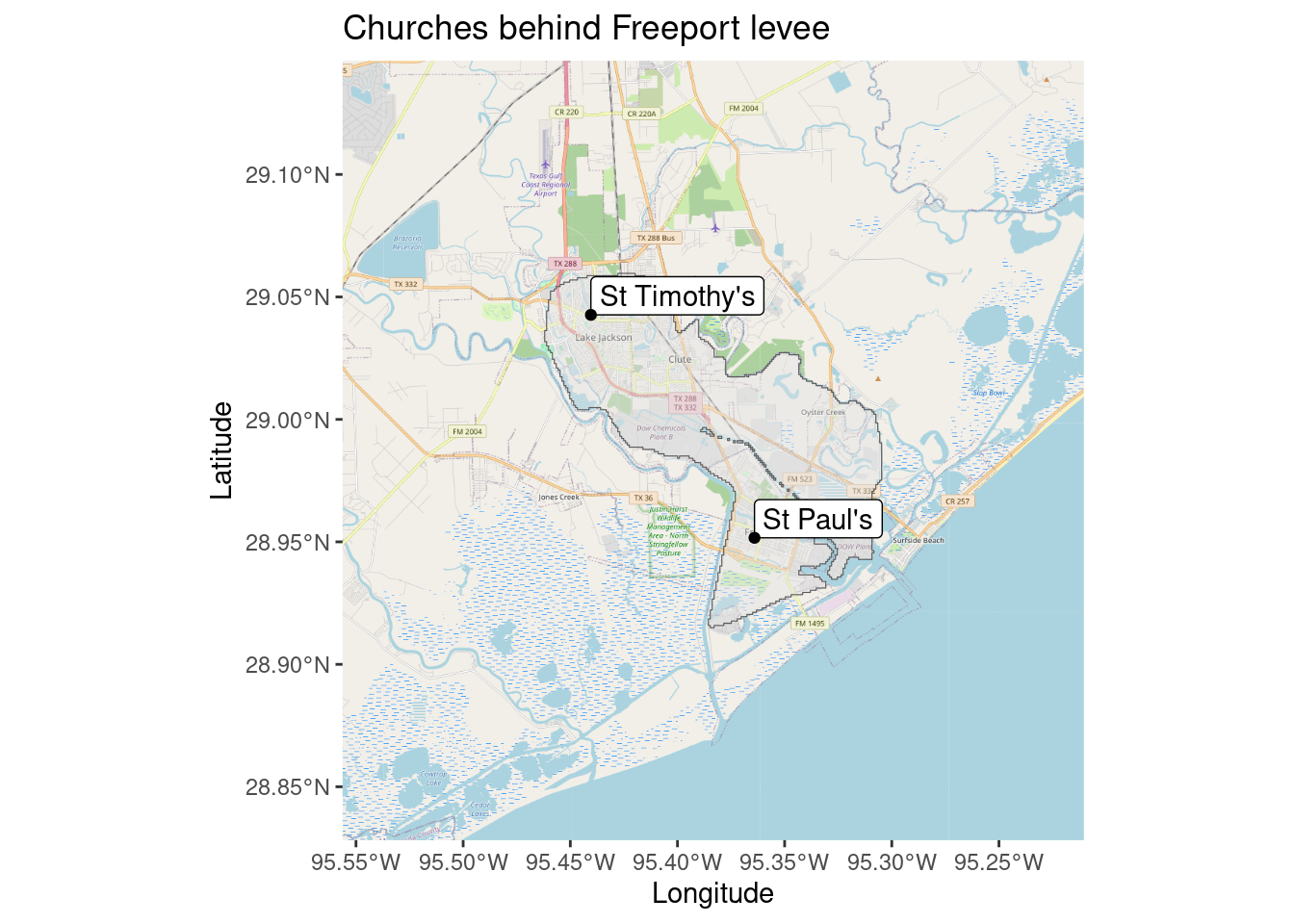library(tidyverse)
library(stars)
library(terra)
library(tidyterra)
googlecrs <- "EPSG:4326"
localUTM <- "EPSG:32615"
inputcrs <- "EPSG:4269" # from metadata file
path <- "/home/ajackson/Dropbox/Rprojects/TexasDioceseCreationCare/Data/"
# Church locations
Parishes <- readRDS(paste0(path, "Parishes.rds"))
# Define an AOI
bbox <- sf::st_bbox(sf::st_transform(Parishes, crs=inputcrs))
bbox["xmin"] <- -96.38
bbox["xmax"] <- -93.66
bbox["ymin"] <- 28.39
bbox["ymax"] <- 30.47
# Expand box by 20% to give a little extra room
expand_box <- function(bbox, pct=0.2){
Dx <- (bbox[["xmax"]]-bbox[["xmin"]])*pct
Dy <- (bbox[["ymax"]]-bbox[["ymin"]])*pct
bbox["xmin"] <- bbox["xmin"] - Dx
bbox["xmax"] <- bbox["xmax"] + Dx
bbox["ymin"] <- bbox["ymin"] - Dy
bbox["ymax"] <- bbox["ymax"] + Dy
return(bbox)
}
Basemap_attribution <- 'attribution: © <a href="https://www.openstreetmap.org/copyright">OpenStreetMap</a> contributors'Read Storm Surge data
Setup
Data downloaded from https://www.nhc.noaa.gov/nationalsurge/
Zachry, B. C., W. J. Booth, J. R. Rhome, and T. M. Sharon, 2015: A National View of Storm Surge Risk and Inundation. Weather, Climate, and Society, 7(2), 109–117. DOI: http://dx.doi.org/10.1175/WCAS–D–14–00049.1
- Data comes in NAD83
Each dataset contains an ESRI World File (.tfw) and metadata .xml file. These GeoTIFFs are 8-bit unsigned integer raster datasets that correspond to 1 ft inundation bins (e.g., Class Value 1 corresponds to the 0-1 ft inundation bin, Class Value 2 corresponds to the 1-2 ft inundation bin, and so on). The maximum Class Value is 21, and inundation in excess of 20 ft is assigned a Class Value of 21. A Class Value of 99 is assigned to leveed areas. A more detailed description of the data can be found in the associated metadata.
Read in the files and clip to AOI
Read in Cat 3 data and use the data extent to build a box.
Do a little test using one church to see what a 100 meter circle looks like.
Plot the rasters, and then make a nice map showing affected churches and the depth of storm surge.
x <- terra::rast(paste0(path, "US_SLOSH_MOM_Inundation_v3/us_Category3_MOM_Inundation_HIGH.tif"))
# Clip to AOI
cropped <- terra::crop(x, bbox)
|---------|---------|---------|---------|
=========================================
# The data has holes in it and I really don't want to take the depth
# at a single point - better would be to average water depth for
# about a block around the church, 100 meters say. Let's see what
# that looks like
pt1 <- sf::st_transform(Parishes, crs=inputcrs)[Parishes$Label=="Saint Augustine of Hippo",] %>%
st_buffer(100) %>% st_as_sf() # Units are meters
# Add ID number to Parishes
Parishes <- Parishes %>%
mutate(ID=row_number())
# pts are really polygons surrounding church locations
pts <- sf::st_transform(Parishes, crs=inputcrs) %>%
st_buffer(100) %>% st_as_sf() # Units are meters
pt <- sf::st_transform(Parishes, crs=inputcrs)[Parishes$Label=="Saint Augustine of Hippo",]
box <- sf::st_transform(Parishes, crs=inputcrs)[Parishes$Label=="Saint Augustine of Hippo",] %>%
st_buffer(1200) %>% st_as_sf() %>% st_bbox()
Base_basemapR <- basemapR::base_map(box, basemap="mapnik", increase_zoom=5)
pt1 %>%
ggplot() +
Base_basemapR +
geom_sf(aes(alpha=0.4))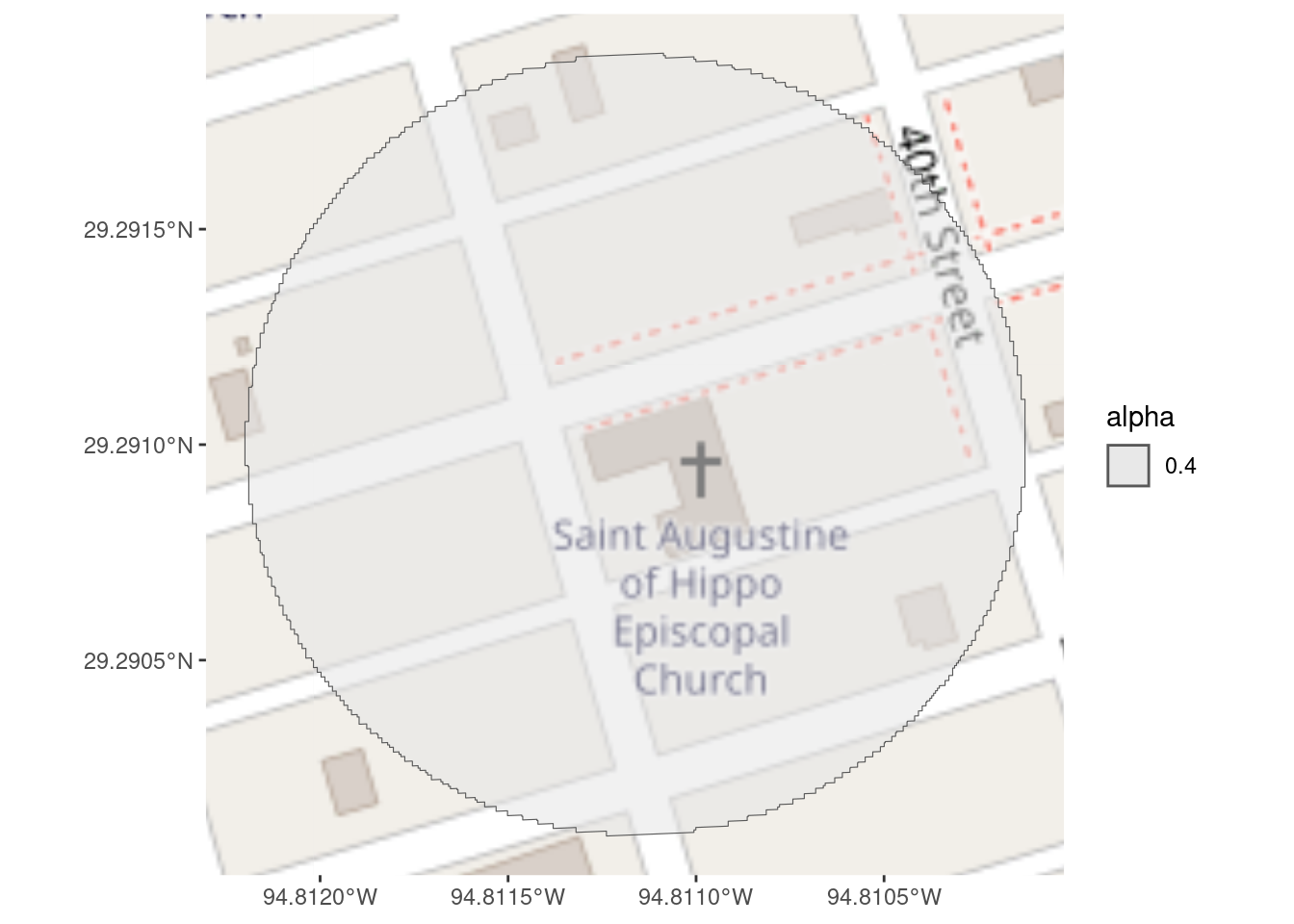
ggplot() +
geom_spatraster(data=cropped) +
geom_sf(data=sf::st_crop(sf::st_transform(Parishes, crs=inputcrs), bbox),
color="black")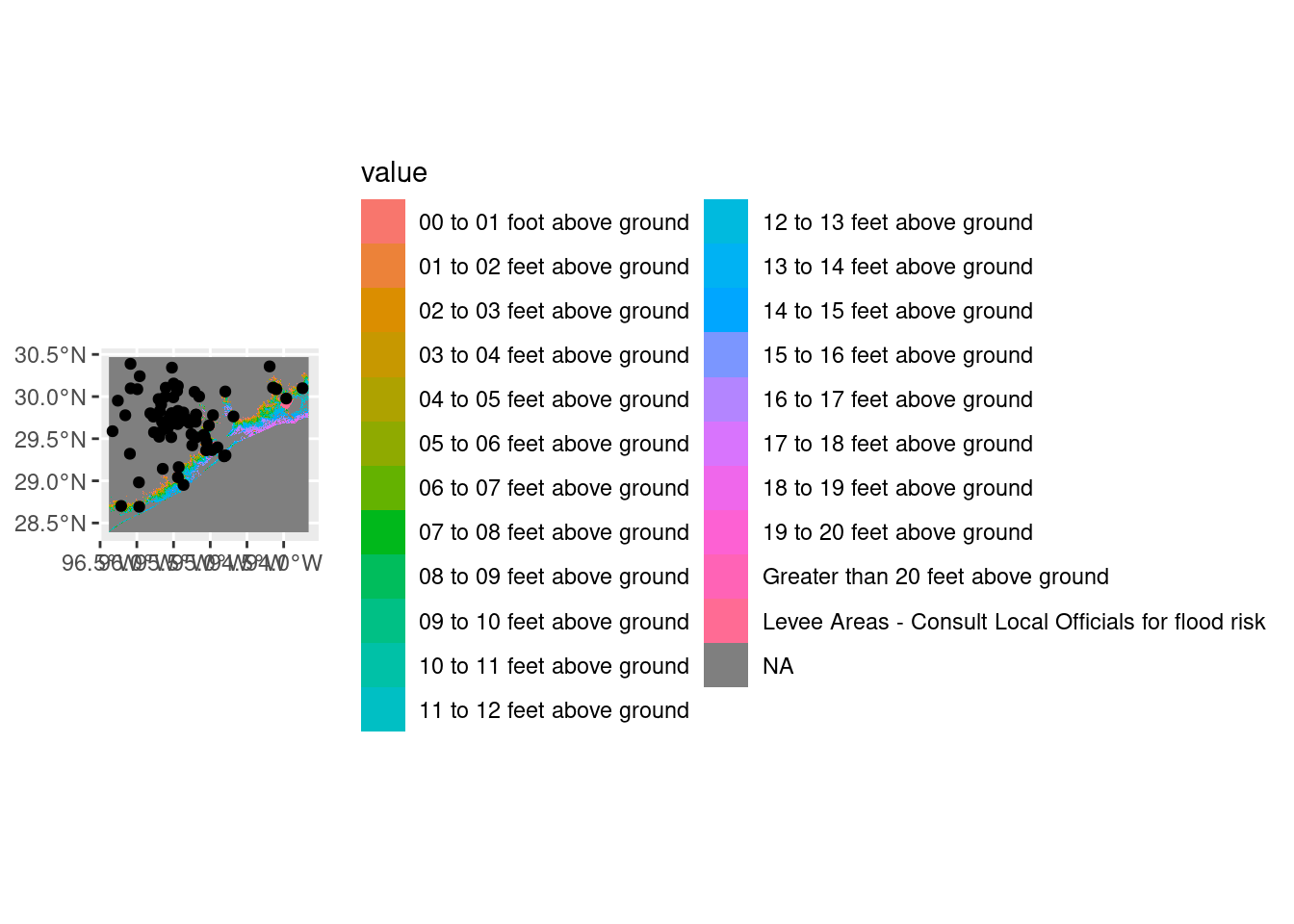
# Extract values at church locations
foo <- cropped %>%
terra::extract(vect(pts), method="bilinear", ID=TRUE) %>%
group_by(ID) %>%
summarize(value=mean(data_range, na.rm=TRUE)) %>%
filter(!is.nan(value)) %>%
filter(value<99) %>%
inner_join(., Parishes, by="ID") %>%
st_as_sf()
box <- sf::st_transform(foo, crs=inputcrs) %>%
st_as_sf() %>% st_bbox() %>% expand_box(., 0.5)
Base_basemapR <- basemapR::base_map(box, basemap="mapnik", increase_zoom=3)
st_as_sf(foo) %>%
ggplot() +
Base_basemapR +
geom_sf(color="black") +
# geom_sf_label(aes(label=paste(stringr::str_remove(Name, "Episcopal Church"), signif(value,2)))) +
ggsflabel::geom_sf_label_repel(aes(label=paste(stringr::str_remove(Name, "Episcopal Church"), signif(value,2), "ft"))) +
labs(title="SLOSH model from NOAA, Cat 3 Hurricane Storm Surge in feet",
x="Longitude",
y="Latitude") +
coord_sf(xlim=c(box$xmin, box$xmax),c(box$ymin, box$ymax))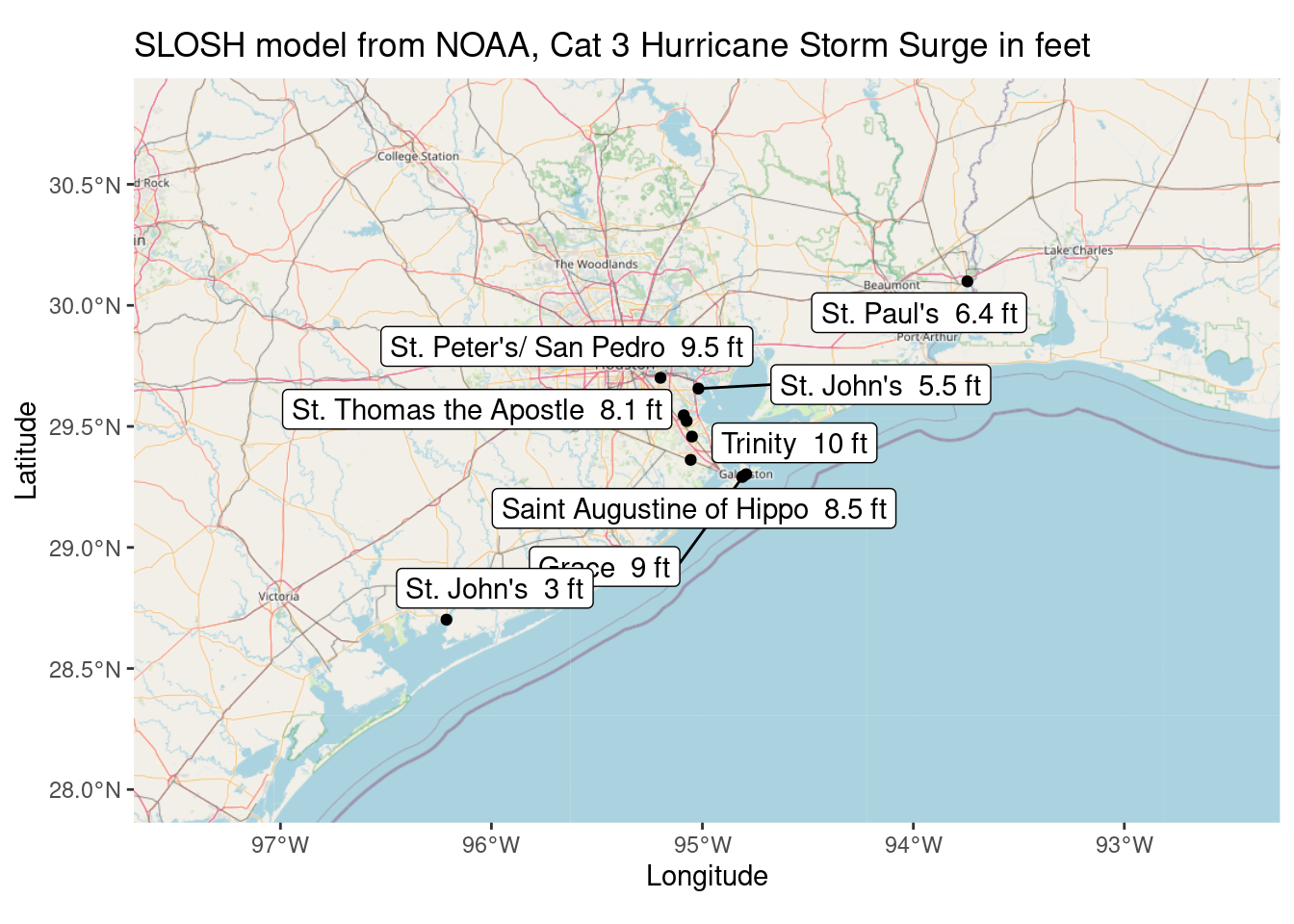
# ggsave("/home/ajackson/Desktop/Cat_1_slosh_model.jpg")Make contours (polygons) from the geotiff grid
Just to see if that would make a suitable display.
# Make a lower resolution grid to save resources
Lowres <- cropped %>%
aggregate(fact=10, fun="median", na.rm=TRUE) %>%
filter(data_range<99)
|---------|---------|---------|---------|
=========================================
ggplot() +
geom_spatraster(data=Lowres) +
geom_sf(data=sf::st_crop(sf::st_transform(Parishes, crs=inputcrs), bbox),
color="black")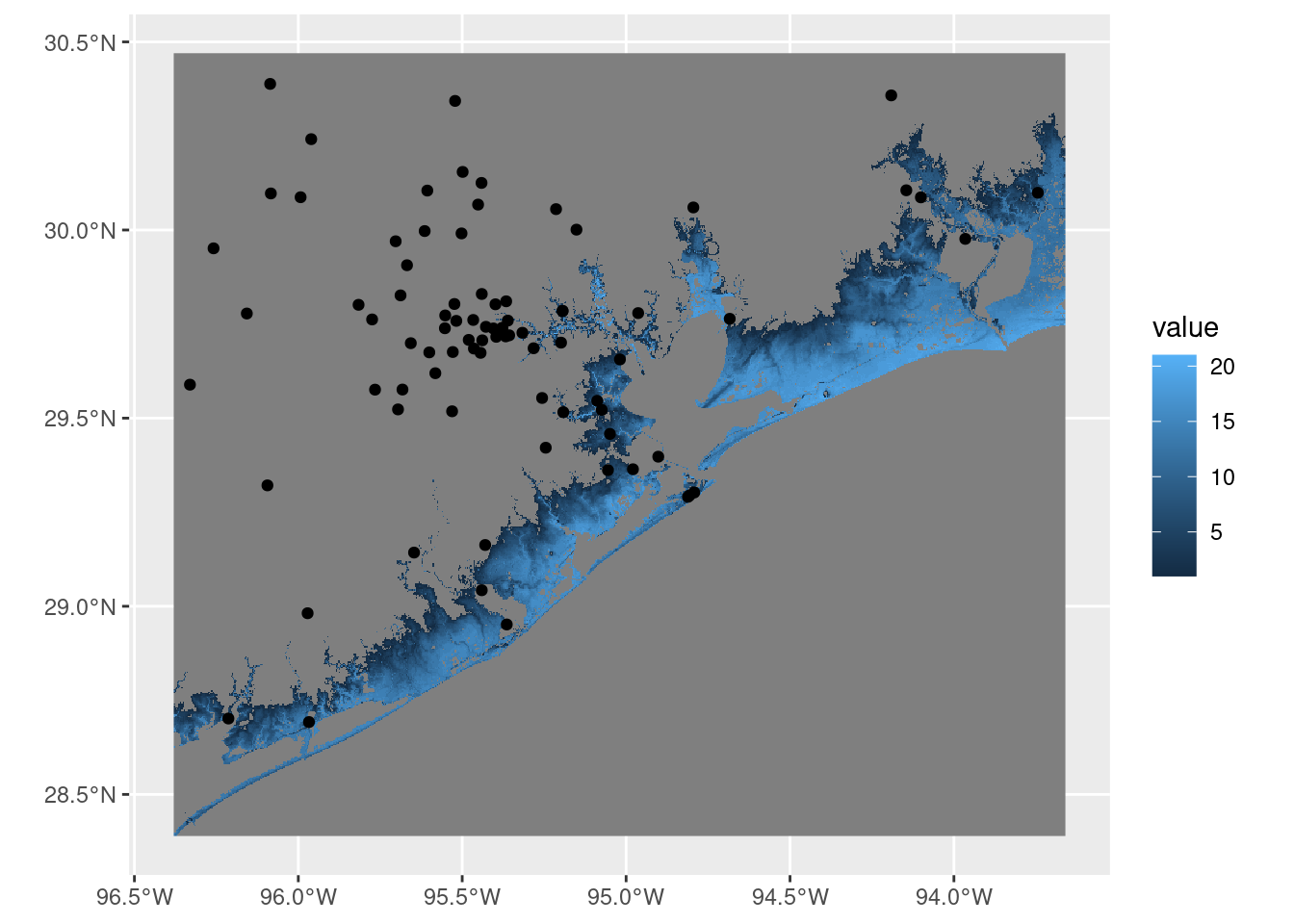
Tinybox <- bbox
Tinybox["xmin"] <- -94.868534
Tinybox["xmax"] <- -94.749265
Tinybox["ymin"] <- 29.239547
Tinybox["ymax"] <- 29.346297
ggplot() +
basemapR::base_map(Tinybox, basemap="mapnik", increase_zoom=3)+
geom_spatraster(data=terra::crop(Lowres, Tinybox), alpha=0.5)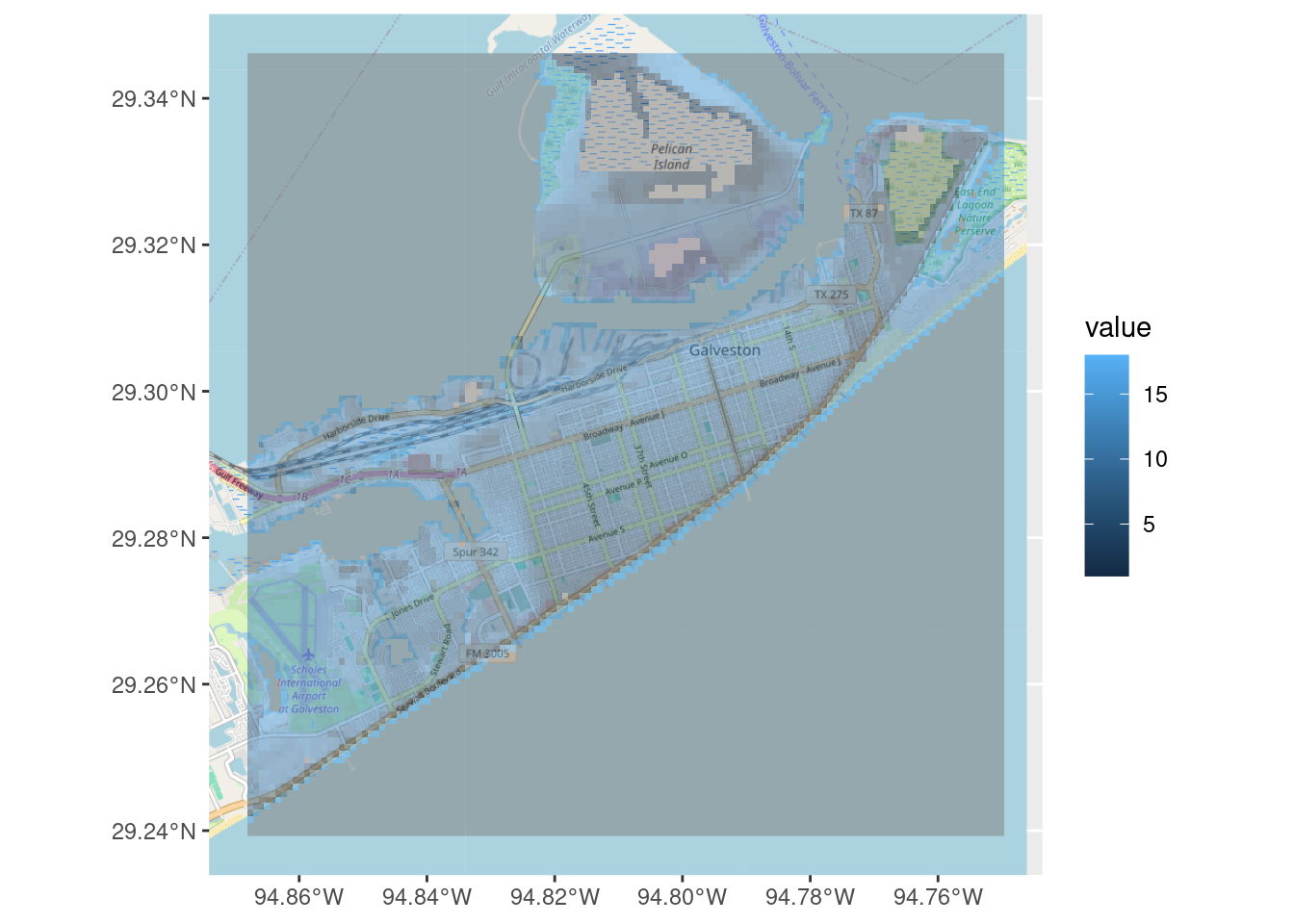
# foo_sm <- terra::focal(foo_terra, w=3, fun=mean)
LowresSm <- Lowres %>%
terra::crop(Tinybox) %>%
terra::focal(w=5, fun=mean, na.rm=TRUE)
Contours <- LowresSm %>%
mapiso::mapiso() %>%
smoothr::smooth(method="ksmooth", smoothness=2)
# smoothr::smooth(mapiso::mapiso(terra::crop(Lowres, Tinybox)),
# method="ksmooth", smoothness=2)
ggplot() +
basemapR::base_map(Tinybox, basemap="mapnik", increase_zoom=3)+
geom_sf(data=Contours, color="black") +
geom_spatraster(data=terra::crop(LowresSm, Tinybox), alpha=0.2)+
scale_fill_gradientn(colors=rainbow(5), limits=c(0,10), na.value="transparent") +
geom_sf(data=sf::st_crop(sf::st_transform(Parishes, crs=inputcrs), Tinybox),
color="black")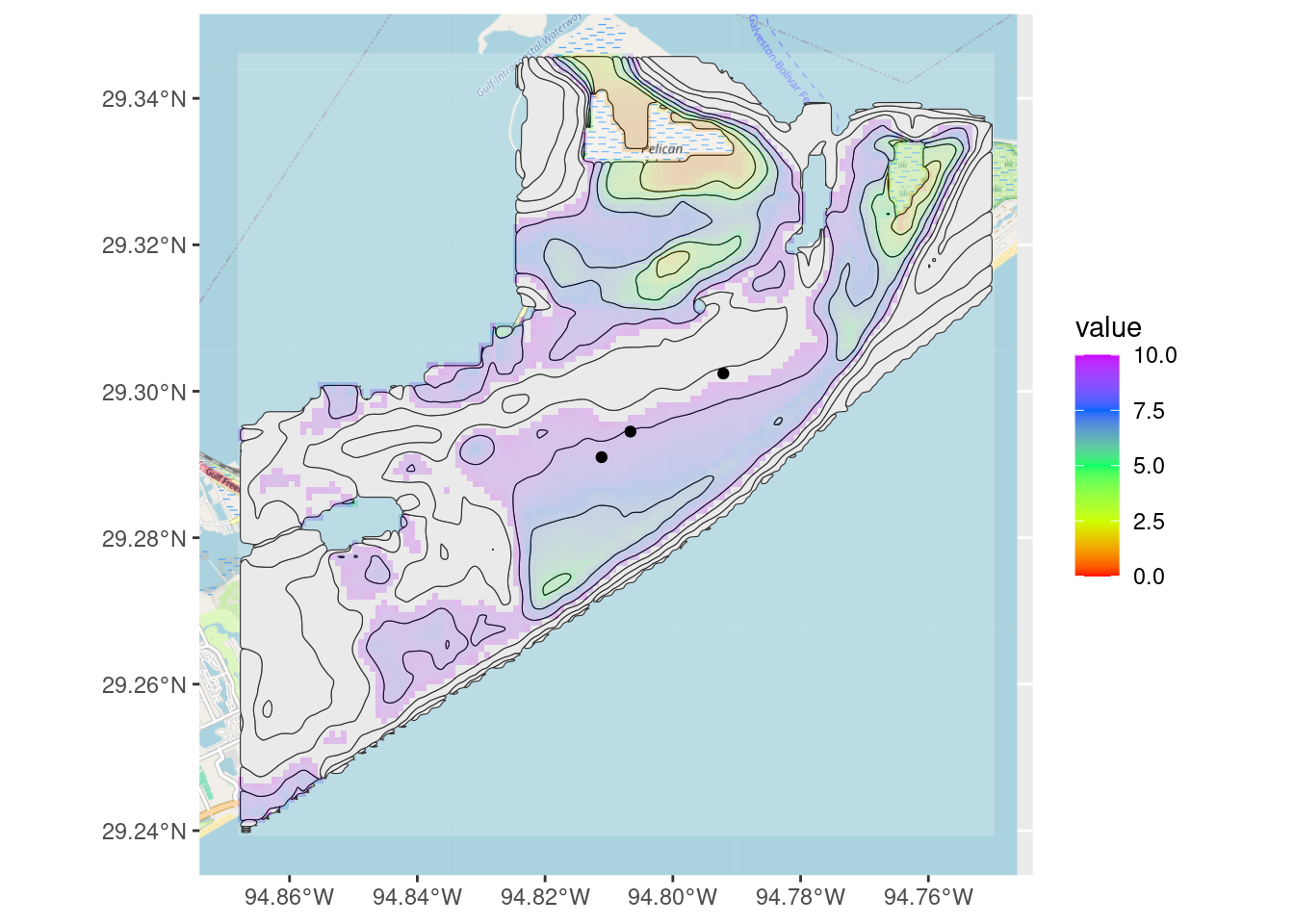
Levee polygons
Extract levees from Cat 1 file and turn into polygons
x <- terra::rast(paste0(path, "US_SLOSH_MOM_Inundation_v3/us_Category1_MOM_Inundation_HIGH.tif"))
# Clip to AOI
cropped <- terra::crop(x, bbox)
|---------|---------|---------|---------|
=========================================
Levees <- cropped %>%
aggregate(fact=10, fun="median", na.rm=TRUE) %>%
filter(data_range>98) %>%
as.polygons() %>%
st_as_sf() %>%
st_make_valid() %>%
st_cast("POLYGON") %>%
mutate(Levee_ID=row_number()) %>%
mutate(Levee_name=case_when(
Levee_ID==1 ~ "Port Arthur",
Levee_ID==2 ~ "Texas City",
Levee_ID==3 ~ "Freeport",
Levee_ID==4 ~ "Matagorda"
)) %>%
filter(!is.na(Levee_name)) %>%
select(Levee_ID, Levee_name, geometry)
|---------|---------|---------|---------|
=========================================
tmap::tmap_options(basemaps="OpenStreetMap")
tmap::tmap_mode("view") # set mode to interactive plots
tmap::tm_shape(Levees) +
tmap::tm_fill(title = "Levees", alpha=0.5, style="cat")+
tmap::tm_text("Levee_name")+
tmap::tm_borders()# saveRDS(Levees, paste0(path, "StormSurge_Levee_Polygons.rds"))Which churches are behind levees?
Make a plot of protected churches
Protected <- st_join(sf::st_transform(Parishes, crs=inputcrs), Levees, join=st_within) %>%
filter(!is.na(Levee_ID))
# Protected <- st_join(Levees, sf::st_transform(Parishes, crs=inputcrs), join=st_contains) %>%
# filter(!is.na(Levee_ID))
tmap::tmap_options(basemaps="OpenStreetMap")
tmap::tmap_mode("view") # set mode to interactive plots
tmap::tm_shape(Levees) +
tmap::tm_fill(title = "Levees", alpha=0.5, style="cat")+
tmap::tm_text("Levee_name")+
tmap::tm_borders() +
tmap::tm_shape(Protected) +
tmap::tm_dots() +
tmap::tm_text("Label", just = "left", xmod = 0.1)Make a separate plot for each levee
# Make small maps around each of the levees showing those churches
for (Levee in c("Port Arthur", "Texas City", "Freeport", "Matagorda")){
temp <- Protected %>%
filter(Levee_name==Levee)
box <- Levees %>%
filter(Levee_name==Levee) %>%
st_bbox() %>% expand_box(., 0.5)
Base_basemapR <- suppressMessages(basemapR::base_map(box, basemap="mapnik", increase_zoom=3))
print(Protected %>%
filter(Levee_name==Levee) %>%
ggplot() +
Base_basemapR +
geom_sf(data=Levees, alpha=0.4) +
geom_sf_label(aes(label=Label),
hjust=0,
vjust=0) +
geom_sf(color="black") +
labs(title=paste("Churches behind", Levee, "levee"),
x="Longitude",
y="Latitude") +
coord_sf(xlim=c(box$xmin, box$xmax),c(box$ymin, box$ymax))
)
}